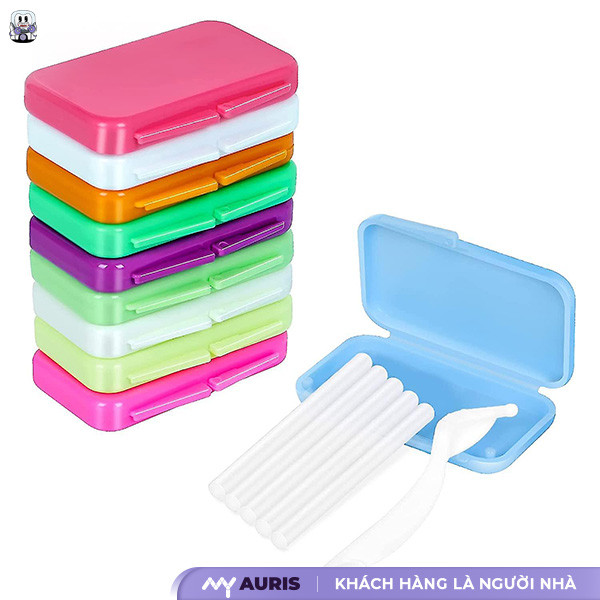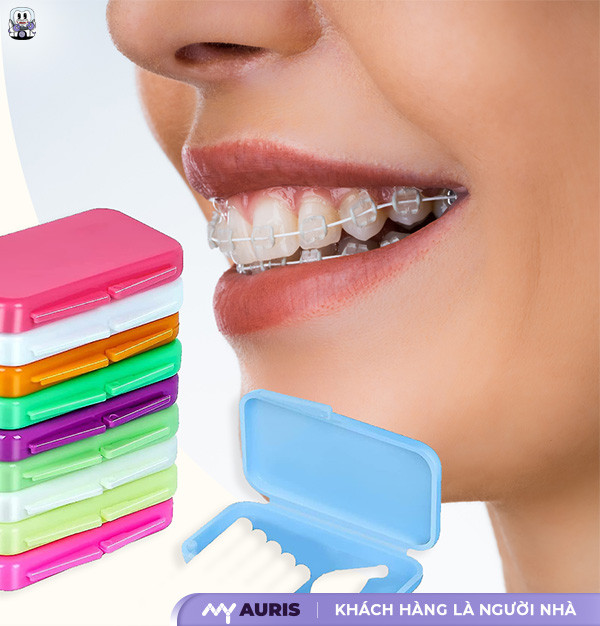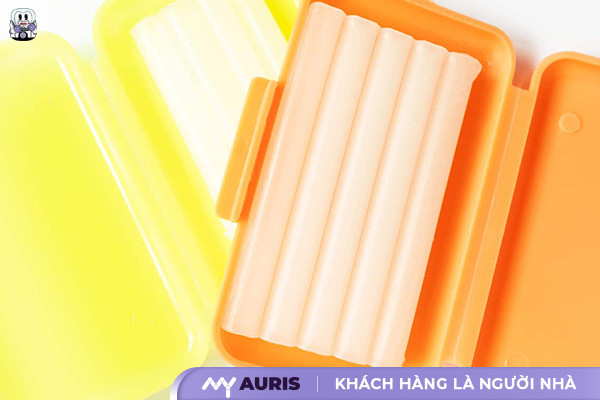Orthodontic wax is an orthodontic aid that helps protect soft tissues in the mouth by creating a barrier between brackets and archwires during orthodontic treatment. It’s a useful and safe solution for people undergoing orthodontic treatment, effectively reducing soreness and discomfort.
What is orthodontic wax?
Orthodontic wax for braces is an essential supportive product for individuals wearing orthodontic appliances, helping to reduce pain and discomfort caused by the appliances rubbing against the soft tissues in the mouth. It commonly comes in sticks approximately 5cm long, primarily made from beeswax, a gentle ingredient extracted from natural honey.
The advantage of orthodontic wax is its high safety. In case of accidental ingestion, the product does not negatively affect health, as its ingredients are completely friendly and easily digestible. However, to ensure optimal effectiveness and hygiene, users should remove the wax before eating, before sleeping, or during daily oral hygiene routines.

Detailed instructions on how to properly use orthodontic wax from a dentist
Step 1: Prepare orthodontic wax
After getting braces, your dentist will usually provide some orthodontic wax for you to use if you feel any rubbing or pain. If you run out or lose it, you can easily purchase more at a pharmacy or order online. Don’t hesitate to ask your dentist for recommendations on reputable places to buy.
In the initial period after getting braces, your mouth won’t be accustomed to the presence of sharp foreign objects like archwires, ligature wires, or the edges of brackets, making your gum area prone to irritation. During this time, you’ll need to use orthodontic wax more frequently. After a few weeks, your lips and cheeks will gradually toughen up, reducing the discomfort – many people even find they no longer need to use wax.
Step 2: Wash your hands before use
Before touching anything that goes into your mouth, you need to thoroughly wash your hands with antibacterial soap, scrubbing for at least 20 seconds, then dry them. This helps prevent infection and limits bacteria from entering your sensitive gum area.
Step 3: Thoroughly clean your mouth
Cleaning your mouth before using wax creates a dry, clean environment, helping the wax adhere better. If you can’t brush, at least rinse your mouth thoroughly and dry your brackets with soft tissue or medical cotton. Avoid placing wax on wet brackets, as it will cause the wax to slide off or detach quickly.
Step 4: Take an adequate amount of wax
When using orthodontic wax, you should take an adequate amount – not too much to avoid waste, and not too little to make application difficult. Use your fingertip to roll the piece of wax for about 5–10 seconds to soften it, making it easier to place on the brackets. Once the wax is soft, cover any sharp or uncomfortable points, such as ligature wires on front teeth, excess archwire, or bracket edges that might rub against your front or back teeth. This helps minimize pain from the brackets, supports better adaptation to the appliances, and reduces the risk of soft tissue damage in your oral cavity.
Step 5: Apply the wax correctly
Roll the wax into a ball with your fingers and gently press it firmly onto the irritated area. If the bracket is deep inside the molar area, you can use your index finger to reach in and gently smooth it. Try to spread the wax evenly so it adheres securely and covers the entire area that needs protection.
Typically, the pain will disappear as soon as the wax is correctly placed. If you still feel pain in other areas, continue to apply more wax to those spots.

Important notes for using orthodontic wax correctly
Orthodontic wax is an effective solution to relieve discomfort caused by brackets rubbing against the soft tissues in the mouth during orthodontic treatment. However, to ensure safety and effectiveness, you should keep some important points in mind:
When orthodontic wax becomes detached or breaks, immediately remove the old wax and replace it with a new piece. Even if the wax hasn’t fallen off, it should be replaced after a maximum of 48 hours, as bacteria and food particles can accumulate on the wax, potentially leading to tooth decay, bad breath, and even gingivitis.
If possible, you should remove the wax before eating or drinking. When chewing, the wax can easily fall off or shift due to contact with saliva, reducing its adhesive effectiveness and increasing the risk of soft tissue damage.
Orthodontic wax does not need to be used continuously throughout the entire orthodontic treatment. Only use it when you experience soreness or irritation from the brackets, especially during the initial phase after getting the appliances.
For chipped teeth, wax can be used temporarily to prevent damage to the lips, cheeks, or tongue. However, this is only a short-term solution – you should see a dentist for examination as soon as possible.
Always carry wax with you. In case the wax falls off due to incorrect use or while eating, you can replace it promptly to maintain comfort.
Besides wax, you can also opt for orthodontic silicone – a material with higher adhesion, unaffected by saliva, and a smoother surface. However, silicone is more expensive and requires the oral cavity to be completely dry before application.

Instructions for proper orthodontic wax storage
Orthodontic wax is a powerful aid in relieving pain from braces, especially during the initial period when brackets can be irritating. However, to maximize its effectiveness, you need to know how to store it correctly.
Basically, orthodontic wax is quite easy to store. The important thing is to pay attention to temperature and environmental factors. Here are detailed guidelines from a professional dentist:
Store orthodontic wax in a cool, stable temperature environment, avoiding places with high temperatures such as near a stove or inside a car parked outdoors.
Avoid direct sunlight on the wax, as high temperatures can cause the wax to melt or lose its texture.
In cold weather, the wax may harden. In this case, you can place the wax next to a warm object, such as a cup of hot water, to soften it before use.
If the wax becomes too soft due to hot weather, place it in the refrigerator for a few minutes to restore its firm consistency.
Thus, storing orthodontic wax is not overly complicated, but requires proper attention to ensure its effectiveness when used. If pain or discomfort persists or does not subside with wax use, you should proactively consult your dentist for the most appropriate and safe course of action.





